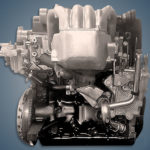The 1.0-liter Renault H4D or 1.0 SCe engine has been produced at the plant in Brazil since 2014 and is used in models such as the Clio and Twingo, as well as the third generation Dacia Logan and Sandero. This power unit on a car from Nissan is known as HR10DE, and on Smart under the symbol M281.
The SCe line: B4A, B4D, H4D, H4M, M4R, M5R, 2TR, V4U, V4Y.
Specifications
| Production years | since 2014 |
| Displacement, cc | 999 |
| Fuel system | distributed injection |
| Power output, hp | 61 – 73 |
| Torque output, Nm | 91 – 95 |
| Cylinder block | aluminum R3 |
| Block head | aluminum 12v |
| Cylinder bore, mm | 72.2 |
| Piston stroke, mm | 81.3 |
| Compression ratio | 10.5 |
| Features | DOHC |
| Hydraulic lifters | no |
| Timing drive | chain |
| Phase regulator | at the intake |
| Turbocharging | no |
| Recommended engine oil | 5W-30 |
| Engine oil capacity, liter | 3.0 |
| Fuel type | petrol |
| Euro standards | EURO 6 |
| Fuel consumption, L/100 km (for Renault Twingo 2017) — city — highway — combined |
5.6 3.9 4.5 |
| Engine lifespan, km | ~250 000 |
| Weight, kg | 81 |
The engine was installed on:
- Renault Clio 5 (BF) since 2019;
- Renault Twingo 3 (C07) since 2014;
- Dacia Logan 3 (LJI) since 2020;
- Dacia Sandero 3 (BJI) since 2020;
- Nissan Micra 5 (K14) in 2017 – 2019 (as HR10DE);
- Smart Fortwo 3 (C453) in 2014 – 2019 (as M281);
- Smart Forfour 2 (W453) in 2014 – 2019 (as M281).
Disadvantages of the Renault H4D engine
- The main thing is to monitor the cooling system, and especially with the rear engine;
- On specialized forums, you can find a couple of cases of replacing the timing chain on a run of about 100,000 km;
- After 100 thousand km, oil consumption occurs due to the occurrence of oil scraper rings;
- There are no hydraulic lifters and every 100,000 km you have to adjust the valve clearance.






